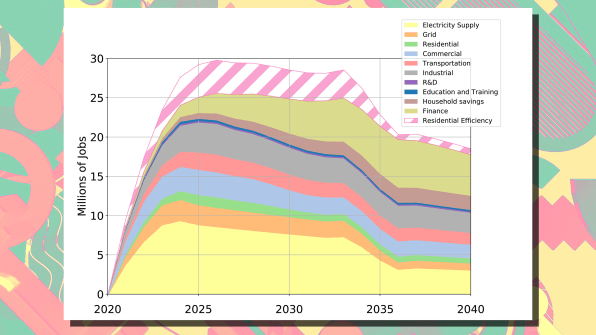How to create 25 million jobs by decarbonizing the economy
As of early July, more than 30 million Americans were collecting unemployment. At some point, when the virus is defeated, they’ll need to return to work—but their old employer might no longer be in business to hire them back. What if we made new, more useful jobs for them instead?
A new report calculates, in detail, what it would take to aggressively transition to a clean energy economy in the U.S. by 2035—the timeline needed to make it possible to hit the target of the Paris climate agreement—and finds that decarbonizing the economy could quickly create 25 million jobs. “For a world looking to bounce back from a pandemic, there is no other project that would create this many jobs,” the authors write.
The report, Mobilizing for a Zero Carbon America, starts with an obsessively detailed analysis of how energy is used in the U.S., and then maps out how everything from transportation to the power sector could be decarbonized over 15 years. That means electrifying almost everything. “Your next car needs to be electric, your next furnace a heat pump, and you need solar on your roof,” the authors write. “This is your personal zero-carbon infrastructure.” It also means building up the power grid with renewable energy to support the newly-electrified economy. Crucially, it doesn’t require inventing new technology; the report looks at how the transition can happen with tech that already exists.

[Image: courtesy Rewiring America]
“I think we have too many people believing we need a miracle, which we don’t,” says Saul Griffith, one of the authors of the report and a MacArthur “Genius Award” Fellow. “That obfuscates the dialogue. I just wanted to emphasize that we are there, and the technology and improvements we need are more along the lines of getting to scale, which will naturally give us big cost reductions.” Griffith and co-author Alex Lasky, a clean energy entrepreneur, have also founded a new nonprofit called Rewiring America focused on rapid decarbonization.
The proposed transition involves a rapid ramp-up of production over the next three to five years, followed by deployment of the new technologies at the maximum feasible rate. Government policy that was created to support fossil fuels would have to change; new low-interest “climate loans” could make it possible for consumers to make climate-friendly purchases. (To stay on track with the Paris climate goals, every major replacement for fossil tech now—from a consumer buying a new car to a replacement for a natural gas plant—should be zero-carbon.) While the government would need to invest to provide incentives and guarantee loans, to the tune of $300 billion a year for 10 years, most of the funding would come from the private sector. All of this production and deployment would create an estimated 25 million well-paid jobs in the near term, distributed across the country. Longer-term, after the new infrastructure is built, that would taper off to around five million sustained jobs (larger than today’s energy industry) to maintain the new technology.
The ability for a green transition to create new jobs is comparable to the mobilization for World War II. “I think the best way to describe what needs to happen politically is we need a president and some level of bipartisanship that will enable FDR levels of urgency in action,” Griffith says. “And you could use either FDR’s response to the Great Depression or to World War Two as your measure of that, but I think it’s actually more analogous to the World War II effort in terms of the speed of industrialization to win that war.”
The report attempts to make the idea of a Green New Deal more concrete. “I think all of the various Green New Deals and aspirational climate plans are narratively in the right direction, but we need to give them some ground truths and build some reality to them about what needs to happen from the ground up,” he says.”Those aspirations are great, but this is actually what you now need to do to get there. I think this is one of the first analyses that really builds out that model from the ground up of what has to happen in order to keep this on target for two degrees.”
The changes would also mean lower energy costs for consumers, and the report calculates that the average American household would save between $1,000 and $2,000 a year. Everyday life wouldn’t necessarily change significantly. “We now have technologies that are transformative, meaning you can now roughly have the same size and shape car, but electric,” Griffith says. “You can have the same size and shape house, but it will be run with electric heat pumps instead of the natural gas furnace. And if we have the sort of that spirit of can-do that America had mid-20th century, there’s every reason to believe that our lives improve when we do this, and we can have and live something like the American dream. It’ll just be electrified, not fossil-fueled.”
(8)



